Not Enough Donor Hair For Transplant
Are you worried about not enough donor hair for transplant? Don’t fret. Many people have been facing this issue that their donor area is too weak or sparse.
Fortunately, various techniques like body hair transplant (BHT), Scalp micropigmentation (SMP), and combined therapies like PRP can help you regain your hair.
In this article, we will explore the donor area limitations, ways to improve donor area health, available treatments, and alternatives. If you are still distressed about insufficient donor hair for transplant, this guide is for you.
What Does Donor Area Mean?
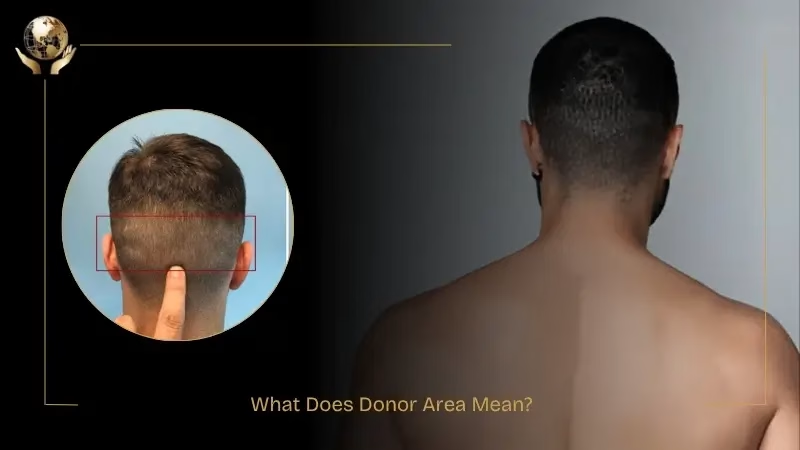
The term donor applies to various operations and isn’t specifically related to hair transplantation. The hair transplant donor area refers to the occipital region at the back of the head.
The surgeons extract hair follicles from this area for transplant. These follicles contain 1 to 4 hairs that they transplanted to bald areas.
However, there are different regions of the body that can be used as donor areas. The hair is taken from the person’s own body to reduce the risk of rejection. Furthermore, the density, texture, and growth direction of donor hair vary from person to person.
Why Is Donor Area Important In Hair Transplant?

The donor area contains follicles that are healthy, genetically resistant, and not susceptible to hair loss. These follicles are the foundation for permanent and naturally looking results in hair transplantation.
Furthermore, the donor area must be preserved because the grafts taken from it will not grow back. Thus, it’s important to prevent the donor area from being thinned out. A healthy donor hair with sufficient density and quality is essential for a successful hair transplant surgery.
Overharvesting can lead to patches on the scalp, scarring, or unnatural hair patterns. With careful planning and expert advice, you can achieve maximum hair growth results.
How To Decide The Donor Area In Hair Transplant?
Surgeons should consider several key factors to ensure the donor area is healthy and provide healthy follicles. This supports long-term, immediate, and effective results.
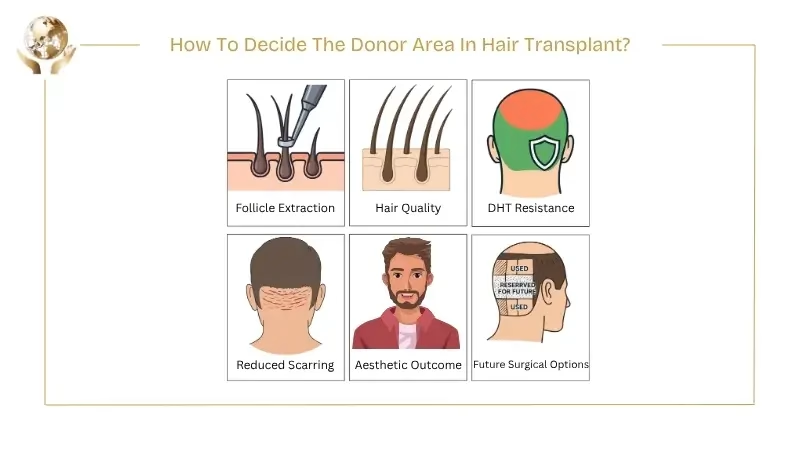
- Follicle Extraction: The donor area must have a high quantity of healthy hair follicles. Also, these follicles must be safely extracted without affecting the natural appearance.
- Hair Quality: Thicker and coarser hair provides better coverage. The number of grafts required for visible density is also less.
- DHT Resistance: The ideal donor site areas are the occipital and parietal scalp regions. These regions are resistant to DHT, a hormone responsible for androgenic alopecia. This will give long-lasting transplant results.
- Reduced Scarring: It’s better to select an area that allows even distribution of graft extraction. This will minimize visible scarring. Techniques like FUE, if performed accurately can leave the donor area scar free.
- Aesthetic Outcome: The selected donor area must give natural-looking results. The hair features must match the transplanted site to fuse smoothly.
- Future Surgical Options: As the donor area is limited, a careful selection and appropriate hair extraction is required. This will preserve grafts for any future surgical procedures.
- Enhanced Transplant Outcomes: The better the donor site, the more successful the coverage is. This will ensure a higher graft survival rate.
- Finite Graft Availability: Surgeons must map the area carefully. With a limited donor area, they must assess the availability of the grafts without over-depleting them.
See Also: Types of Alopecia
How Do Surgeons Determine If You Have Enough Donor Hair?
Surgeons assess patients by thoroughly evaluating the availability and quality of the donor area. They mainly focus on the back and sides of the scalp.
Here are some key factors that they consider:
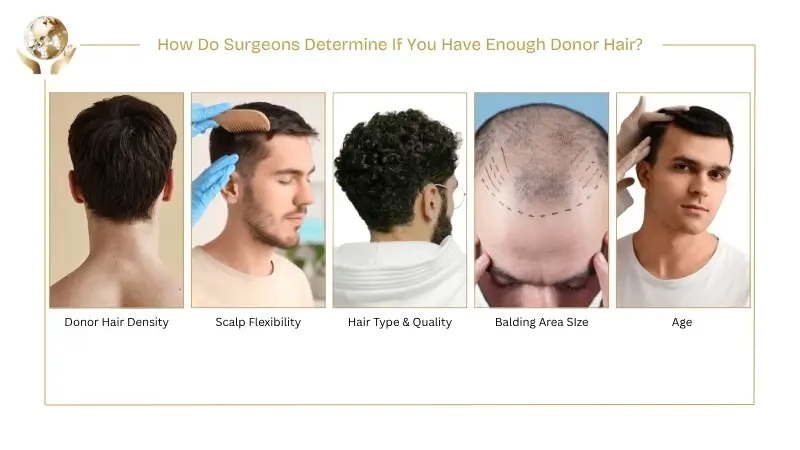
- Donor Hair Density – They measure how many follicular units exist per square centimetre in the donor area. A higher follicular count means a greater supply of grafts is available for better coverage.
- Scalp Flexibility – The more the scalp is flexible, the large graft extraction can be performed. It is ideal for cases where large numbers of grafts are required.
- Hair Type & Quality – The type, texture, and pattern of hair affect the outcome. The curly, thick hair has more coverage than fine, thin strands.
- Balding Area SIze – The amount of hair loss determines the number of hair grafts required. Large bald areas need more hair for coverage for satisfactory results.
- Desired Aesthetic Outcome – Each patient has different cosmetic goals. The density, overall look, and hairline shape determine how much donor hair is required.
- Age & Hair loss stability – Hair loss gets in proper stability after the age of 25. It becomes easier for the surgeon to predict the long-term treatment results and plan the procedure accordingly.
Reasons For Naturally Limited Donor Hair
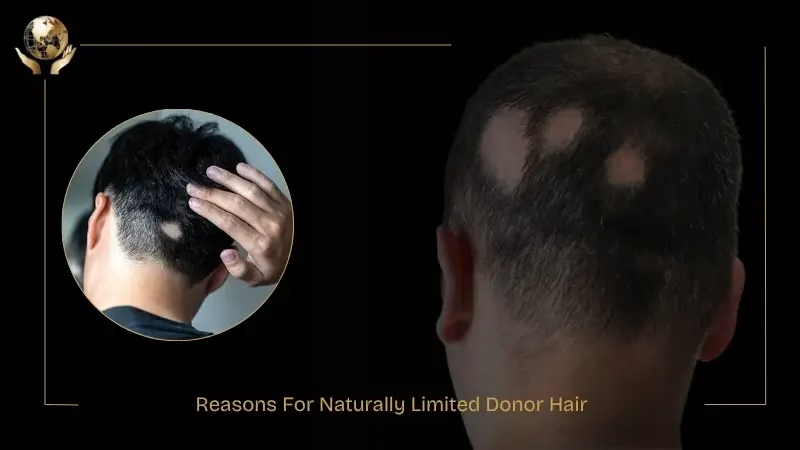
Not everyone is an ideal candidate for hair loss transplant. Some have limitations in donor hair availability.
Several causes contribute to having not enough donor hair transplant, including:
- Conditions like alopecia areata or scarring alopecias damage the donor region.
- Thinning of donor area due to androgenic alopecia.
Causes Of Donor Area Damage From Prior Procedures
The availability of donor hair can also be limited due to damage from previous hair restoration procedures. This can be caused by:

- Damage of hair follicles during graft harvesting.
- Improper storage of graft and handling.
- Poor dissection techniques.
- Scarring in the donor area.
- Utilizing old plug techniques lead to hair wastage.
- Crescent deformity occurs due to combined poor oxygenation and transection.
- Placing the transplanted grafts too close together (especially in the scalp with inadequate blood supply from smoking or sun-damage).
Signs & Symptoms Of Insufficient Donor Area
It’s important to identify the insufficient donor area before the hair transplant surgery. Here are some common signs and symptoms that indicate the inadequacy of the donor area:

Low Hair Density
If the donor area is weak, it won’t provide enough space for hair to achieve the desired density. The scalp at the back or sides appears patchy with visible wide gaps between strands.
Overharvesting
It occurs when a large number of hair follicles are extracted from the donor area. This leads to visible hair thinning or scarring.
Uneven Hair Texture Or Quality
If the donor area shows inconsistencies both in thickness and texture, it is unsuitable for transplantation. This is usually seen in the frontal hairline.
Excessive Scarring, Swelling, & Redness
Some scarring and redness is normal after a hair transplant. However, excessive scarring, swelling, and redness indicate problems of damaged donor area or the risk of infection.
Poor Scalp Laxity
Tight or rigid scalp don’t allow the surgeons to extract sufficient grafts, particularly in FUT technique.
What To Do If You Don’t Have Enough Donor Hair?
If you don’t have enough donor area for transplant, your plastic surgeon will suggest alternative options. One option is chest hair extraction. Here are some ways to overcome this problem:
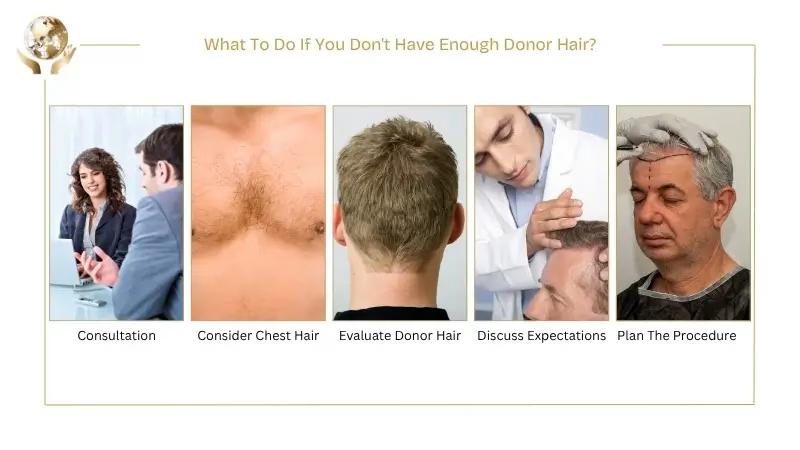
- Consultation
The first thing is to schedule a consultation with the plastic surgeon. He will assess and determine your scalp and discuss outcomes for the best possible treatments.
- Consider Chest Hair Extraction
It is also known as Body Hair Transplantation (BHT). This technique involves extracting hair from the back, chest, and beard, transplanting them to the scalp. Chest hair is a suitable donor area for hair transplantation. Its texture and growth cycle is the same as that of a scalp.
- Evaluate Donor Hair Quality
The plastic surgeon will assess the quality and appropriateness of the donor’s hair from the chest or other body areas. He will look for the factors like hair density, coarseness, and natural growth direction to ensure best results.
- Discuss Expectations & Limitations
It’s essential to have realistic expectations when choosing chest hair extraction for hair transplantation. As it provides additional hair for transplantation in the scalp, but the results differ from traditional scalp hair transplantation.
The plastic surgeon will discuss the limitations about chest hair extraction in terms of density and coverage.
- Plan The Procedure
If body hair extraction is a wise option, then the plastic surgeon will make a treatment plan. It involves techniques like Follicular Unit Extraction (FUE) to harvest the hair follicles, transplanting them to the scalp.
- Follow Postoperative Care Instructions
It’s important to follow the postoperative instructions of the surgeon for optimal results. These include:
- Avoiding strenuous activities
- Protecting the treated area from sun exposure
- Adhering to skincare routine
- Follow-Up Appointments
Make sure to attend scheduled follow-up appointments. Your surgeon will check the healing process and guide you about care for the transplanted hair.
See Also: High Density Hair Transplant
Are Hair Transplants With Weak Donor Areas Successful?
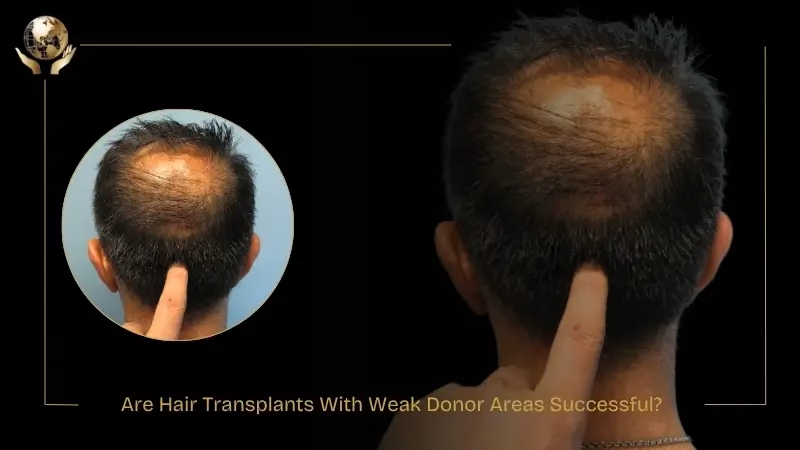
If the hair transplantation is performed by an expert hair transplant surgeon, then it can be permanent and successful. It is usually seen in cases of androgenetic alopecia or male pattern baldness.
Most patients get the results in 6 to 9 months after the surgery. While some take 12 months.
The success varies doctor to doctor, depending upon their skills, expertise, and the available technologies. Surgeons with a good reputation have a 100% success rate. The results are best accomplished when the surgeon and patient cooperate to create a treatment plan for hair recovery.
Healthy vs Unhealthy Donor Area – A Comparison
A successful hair transplant surgery depends upon the condition of your donor area. The table below highlights the differences between a healthy and unhealthy donor area.
| Feature | Healthy Donor Area | Unhealthy Donor Area |
| Hair Density | 60–100 follicles/cm² | Less than 40 follicles/cm² |
| Follicular Units | 2–3 hairs per unit (ideal for transplant) | Mostly single-hair units or miniaturized hairs |
| Scalp Condition | Smooth, scar-free, normal elasticity | Scarring, inflammation, or reduced flexibility |
| Previous Surgeries | No or minimal prior harvesting | Overharvested with visible gaps or scars |
| Hair Quality | Thick, coarse, and pigmented | Thin, fragile, or light-colored hair |
| Suitability for Extraction | High — can yield 2,500–4,000+ grafts | Low — risk of poor results and visible thinning |
| Long-Term Viability | Sustainable for future procedures | May not support future sessions |
Does Hair In The Donor Area Grow Back?
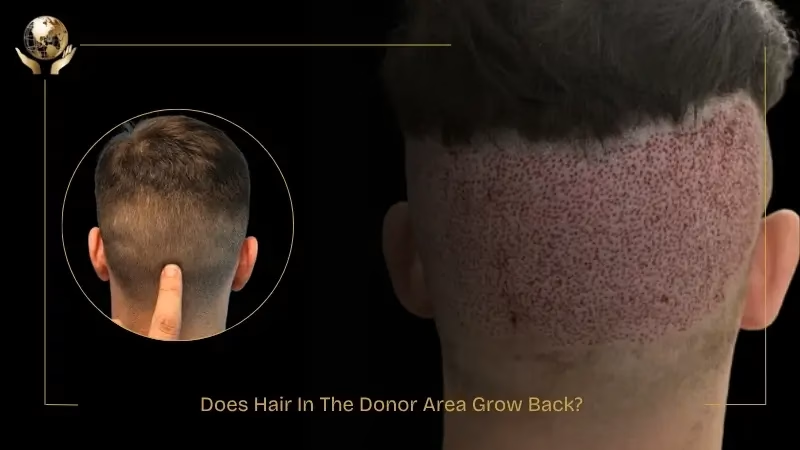
The extracted hair from the donor area does not grow back. The hair follicles are removed permanently during transplantation. However, a partial removal of hair can be seen if the surgeon performs the procedure skillfully and strategically.
That is why it’s essential to choose an experienced surgeon. The surgeon must understand proper planning, technique, and the distribution of extractions to maintain a natural, dense appearance. This will ensure no visible thinning or scarring.
Furthermore, hair around the extraction site tends to grow normally, maintaining the aesthetic appearance of the donor area. If proper care is followed, the donor area can remain healthy and support future procedures.
Does Harvesting Or Grafts Leave Scars On The Donor Area?
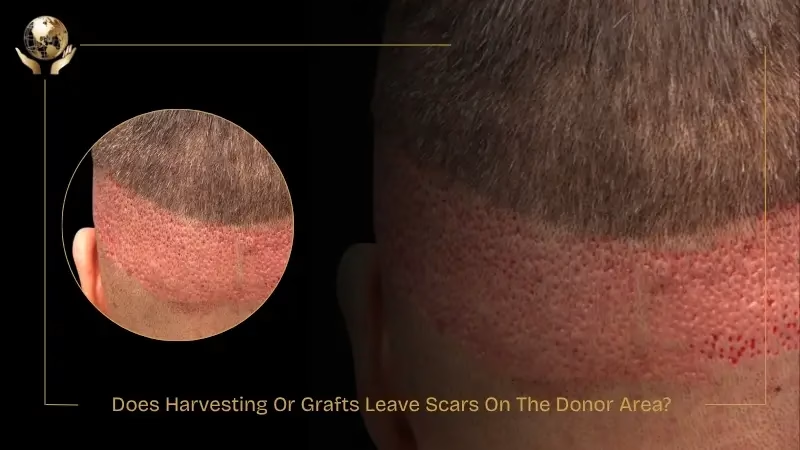
There are many advanced techniques, through which grafts are removed one by one, minimizing trauma to the skin. The process leaves tiny red holes that heal all on their own within days. Also, this requires a good donor area for hair transplant.
The surgery must be performed by a skilled surgeon to have a scar-free hair extraction. FUE hair transplant methods which are designed to prevent visible scarring, include:
- Manual FUE
- DHI (Direct Hair Implantation)
- Women’s Hair Transplant
- Regenera Activa Hair Transplant
After a well-executed hair transplant surgery, proper aftercare ensures the donor area remains smooth and natural.
Timeline For Hair Transplant With A Weak Donor Site
After the hair transplant, the hair follicles enter the resting phase.
| Stage | Time Period | What to Expect |
| Initial Shedding & Resting Phase | 2-4 Weeks | Hair follicles enter a resting phase, and some tiny transplanted hairs are shed. This is a normal part of the process. |
| Early Growth | 2-3 Months | You may not see significant new hair growth. The follicles are adjusting to their new location. |
| Visible Eruption | 3-4 Months | New, fine hair begins to erupt from the transplanted follicles. |
| Noticeable Growth | 6-7 Months | 40% to 50% of the new hair has grown. The hair begins to thicken. |
| Significant Density | 9-10 Months | Around 90% of the hair has become visible across the scalp. |
| Final Results | 12-18 Months | Complete hair growth, and the final appearance and density are seen. |
See Also: Hair Transplant Growth & Timeline
What Are The Alternatives To Hair Transplant In Turkey?
Some of the best alternatives for male patients with insufficient donor hair density in Turkey, include:

- Medications: These help the patients grow back their missing hair. It’s better to consult with a dermatologist before purchasing the hair growth medications.
- Laser Therapy: It is a faster alternative that stimulates the growth of the hair follicles. This is an advanced and a new version to provide good results for severe hair loss problems.
- PRP: The platelet rich plasma (PRP) is another alternative that separates plasma from the blood by centrifugation. It is then injected into the scalp in the hair deficient areas.
- Scalp Micropigmentation: It is the best option for patients suffering from severe hair loss. This technique involves tattooing tiny pigment dots on the scalp which enhance overall scalp aesthetics.
- Body Hair Transplant: Men with insufficient donor area are recommended body hair transplant. The chest and the back are the alternative donor sites with high hair density.
See Also: Does Biotin Help With Hair Loss?

This article is medically reviewed by Medical Aesthetic Dr. Ali Khalil (PHD)
See Our Doctors & Surgeons
What if there is no donor area for hair transplant?
Options like BHT, SMP, Combination therapies like PRP and laser overcome the depletion of the donor area.
How do I know if I have enough donor hair?
Consult a hair transplant surgeon who will evaluate hair density, quality, scalp laxity, and the extent of hair loss.
How many donor hairs does the average person have?
The average person has approximately 10,000 to 15,000 follicular units.
What is a weak donor area hair transplant?
Donor area that has low density, thinning of hair and not resistant to balding.
How much area will 2500 grafts cover?
A 2500 graft covers the frontal or the crown area and not the entire scalp.
How to strengthen the donor area?
Maintain scalp hygiene, avoid harsh chemicals, tight hairstyles, eat a nutrient-rich diet, and follow medicines according to doctor’s prescription.
Why is my donor area patchy?
Patchiness is due to overharvesting, alopecia, trauma, hair thinning, or uneven hair extraction.






